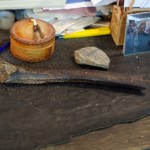 The femur from which the DNA samples originated. Bence Viola, MPI EVA Svante Pääbo’s lab at the Max Planck Institute for Evolutionary Anthropology in Germany has mastered the process of obtaining DNA from ancient bones. With the techniques in hand, the research group has set about obtaining samples from just about any bones they can find that come from the ancestors and relatives of modern humans. In their latest feat, they’ve obtained a genome from a human femur found in Siberia that dates from roughly the time of our species’ earliest arrival there. The genome indicates that the individual it came from lived at a time where our interbreeding with Neanderthals was relatively recent, and Europeans and Asians hadn’t yet split into distinct populations. The femur comes from near the town of Ust’-Ishim in western Siberia. It eroded out of a riverbank that contains a mixture of bones, some from the time where the sediments were deposited (roughly 30-50,000 years ago), and some likely older that had been washed into the sediments from other sites. The femur shows features that are a mixture of those of paleolithic and modern humans, and lacks features that are typical of Neanderthal skeletons. Two separate samples gave identical carbon radioisotope dates; after calibration to the 14 C record, this places the bone at 45,000 years old, give or take a thousand years. That’s roughly when modern humans first arrived in the region. That also turned out to be consistent with dates estimated by looking at the DNA sequence, which placed it at 49,000 years old (the 95 percent confidence interval was 30-65,000 years). Read 11 remaining paragraphs | Comments
The femur from which the DNA samples originated. Bence Viola, MPI EVA Svante Pääbo’s lab at the Max Planck Institute for Evolutionary Anthropology in Germany has mastered the process of obtaining DNA from ancient bones. With the techniques in hand, the research group has set about obtaining samples from just about any bones they can find that come from the ancestors and relatives of modern humans. In their latest feat, they’ve obtained a genome from a human femur found in Siberia that dates from roughly the time of our species’ earliest arrival there. The genome indicates that the individual it came from lived at a time where our interbreeding with Neanderthals was relatively recent, and Europeans and Asians hadn’t yet split into distinct populations. The femur comes from near the town of Ust’-Ishim in western Siberia. It eroded out of a riverbank that contains a mixture of bones, some from the time where the sediments were deposited (roughly 30-50,000 years ago), and some likely older that had been washed into the sediments from other sites. The femur shows features that are a mixture of those of paleolithic and modern humans, and lacks features that are typical of Neanderthal skeletons. Two separate samples gave identical carbon radioisotope dates; after calibration to the 14 C record, this places the bone at 45,000 years old, give or take a thousand years. That’s roughly when modern humans first arrived in the region. That also turned out to be consistent with dates estimated by looking at the DNA sequence, which placed it at 49,000 years old (the 95 percent confidence interval was 30-65,000 years). Read 11 remaining paragraphs | Comments
Read this article:
45,000-year-old modern human bone yields a genome







